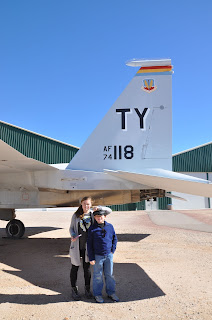We started off this month with a visit to the Pima Air and Space Museum. (Sorry, I had to pause for the playing of the National Anthem. One of the cool things about being on the base is that every weekday at 5:00 in the evening they play "To the Color - Retreat" and the National Anthem. Everything stops. We pause and face the music with our hands over our hearts.) Now, let's get back to the museum.
On Monday, we took two docent led tours. The first tour took us to the AMARG better known as the Boneyard on Davis-Monthan Air Force Base. The Boneyard is a place for all branches of the military to store aircraft.
Tucson is a good place for storing aircraft due to the dry climate and the soil. The dirt is so hard that concrete is not needed.
There were many planes on Celebrity Row. My favorite was the F-117. Please see photo below. By the way it is a stealth fighter.
The other docent led tour was a tram tour of the outside aircraft display area around the hangars of the museum. One of the planes we saw was an F-15 that Pop flew when he was stationed at Luke. The plane was moved to Tyndall, thus the "TY" on the tail.
Another interesting story that the docent told us was about the Candy Bomber. One of the missions that Americans participated in after the close of World War II was that of flying supplies into West Berlin. One day children came up to pilot Gail Seymour Halverson. He interacted with the children, and then when he had to leave he wanted to give them something. He only had two pieces of gum. He was afraid that they would fight over it, but he gave it to them anyway. They didn't fight. They looked at it, smelled it, and even smelled the wrapper. Then the pilot said, "I will bomb you guys candy." So, the next time he came he bombed them candy. Then other pilots did it, too. Sometime later he got called into the commander's headquarters expecting he was in trouble. Instead of being in trouble, the commander expanded the operation calling it "Little Vittles". By the end of the Berlin airlift they had dropped 23 tons of chocolate.
Another story was about a plane which started a flat spin. Ordinarily, one cannot recover from a flat spin, so the pilot ejected. For some reason the plane came out of the spin and safely landed all by itself on a field of snow somewhere in Montana. The plane was completely unharmed and was returned to service.
On Tuesday, Mom, Eva, and I went back to the museum. We visited the Space Gallery first. I flew a moon landing simulator and a space station docking simulator.
Then, we went to listen to another docent tell us about WWII. We learned a lot about the B-24 seen below.
Eva wanted to see some planes that were art pieces. These were her favorites.
They also had a lot of helicopters. It was so cold outside that the helicopters were warm, so Eva and I hugged this one.
We visited a memorial to the 390th, a bombing group stationed in England during WWII. The memorial included a restored B-17.
Our last tour was about general aviation. It began with the story of the Wright Brothers. Then we learned about one of the smallest planes to ever fly, the Bumble Bee.
We also learned about a naval float plane. In the early production of the plane they didn't have wheels like the one pictured here. The early planes were stored on the water. These planes flew over the water as low as 1500 feet. Our docent flew one in the Korean War.
I'm having lots of fun and look forward to my next blog.













Wow, sounds so interesting. I want to see all the planes, especially the one Papa flew. Eva and Jack, did you get air sick when you flew the red "crop duster"?
ReplyDeleteWow, so great to see the connections to your family's past.
ReplyDelete